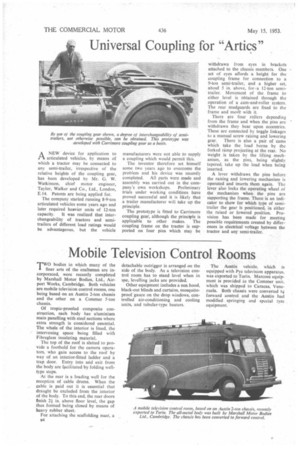Universal Coupling for "Artics"
Page 38

If you've noticed an error in this article please click here to report it so we can fix it.
ANEW device for application to articulated vehicles, by means of which a tractor may be connected to any semi-trailer, irrespective of the relative heights of the coupling gear, has been developed by Mr. G. W. Watkinson, chief motor engineer, Taylor, Walker and Co., Ltd., London, E.14. Patents are being applied for.
The company started running 8-9-ton articulated vehicles some years ago and later required heavier units of 12-ton
capacity. It was realized that interchangeability of tractors and semitrailers of different load ratings would be advantageous, but the vehicle
manufacturers were not able to supply a coupling which would permit this.
The inventor therefore set himself some two years ago to overcome the problem and his device was recently completed. All parts were made and assembly was carried out in the com pany's own workshops. Preliminary trials under working conditions have proved successful and it is likely that a trailer manufacturer will take up the principle.
The prototype is fitted to Carrimore coupling gear, although the principle is applicable to other makes. The coupling frame on the tractor is supported on four pins which may be withdrawn from eyes in brackets attached to the chassis members. One set of eyes affords a height for the coupling frame for connection to a 9-ton semi-trailer, and a higher set, about 5 in. above, for a 12-ton semitrailer, Movement of the frame to either level is obtained through the operation of a cam-and-roller system. The rear mudguards are fixed to the frame and mov'e with it.
There are four rollers depending from the frame and when the pins arc withdrawn they bear upon eccentrics. These are connected by toggle linkages to a manual screw raising and lowering gear. There is also a pair of cams which take the load borne by the forked ramp projecting at the rear. No weight is taken by the lifting mechanism, as the pins, being slightly tapered, take up the load when being inserted.
A lever withdraws the pins before the raising and lowering mechanism is operated and inserts them again. The lever also locks the operating wheel of the mechanism when the pins are supporting the frame. There is an indicator to show for which type of semitrailer the gear is positioned, in either the raised or lowered position. Provision has been made for meeting possible requirements created by differences in electrical voltage between the tractor and any semi-trailer.




























































































